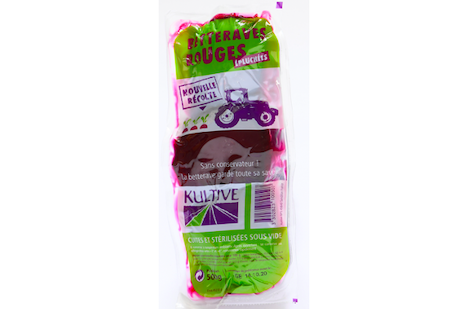Kultive supplies red beet every month of the year. The campaign takes place in 2 stages. “We start harvesting in September with the so-called conservation beet, which we work with until April. Then, the fresh beet arrives in May and the campaign lasts until September,” explains Alexandre Picault, sales director at Kultive.

A deficit in supply
Much like many other field products this year, the red beet has suffered from the summer heat and the drought. “There is a deficit in supply due to the lack of products. The beets were not able to grow to their full potential because of the water shortage. There is also a lot of uncertainty regarding the quality of conservation of the products, which requires more sorting before cooking and processing. This leads to a greater loss of volume at the marketing stage because the products must present an optimal quality that meets the specifications of the certifications under which they are sold.”
The production is processed directly on site
Kultive works with a producer who processes his own beets on his property. “The beets are grown on 300 hectares in the Loiret and Cher departments. Our producer has his own processing unit, which is relatively rare in France. It is actually one of our strengths because the beets, with their high betacyanin content (responsible for the red color), require their own processing unit to prevent the red color from being found on other products. This is why we also export to Europe, because few of the countries that produce red beets process them as well.”
A relatively stable market
In terms of consumption, the red beet market has been relatively stable in recent years. Its evolution is directly related to sales dynamics. “This market only survives with the help of promotional actions and events organized around the product. If we are inactive, the red beet market tends to fall apart, but when we make efforts to stimulate sales, the results are felt right away. This allows us to maintain a certain balance between supply and demand. This year for example, our volumes are more limited so we will not overdo it in terms of promotion.”
A diversified offer
Of the 10,000 tons of beets marketed by Kultive, all of them are certified Demain La Terre, HEV and Global GAP. The station is 100% IFS Browker and 10% of the volumes are organic. Kultive mostly sells its beets vacuum packed in bags of 500g or 4.5 kg. “We also sell raw beets and we supply the catering industry with cubes of beets in 2kg bags. And of course, during the high season, we also have some crapaudine beet, an ancient beet whose taste is particularly popular among red beet lovers.”
For more information: 
Alexandre Picault
Kultive S.A.S.
190 allée du bois vert
45640 Sandillon, France
Phone: 02 38 49 33 49
Fax: 02 38 49 33 48
contact@kultive.com
www.kultive.fr
